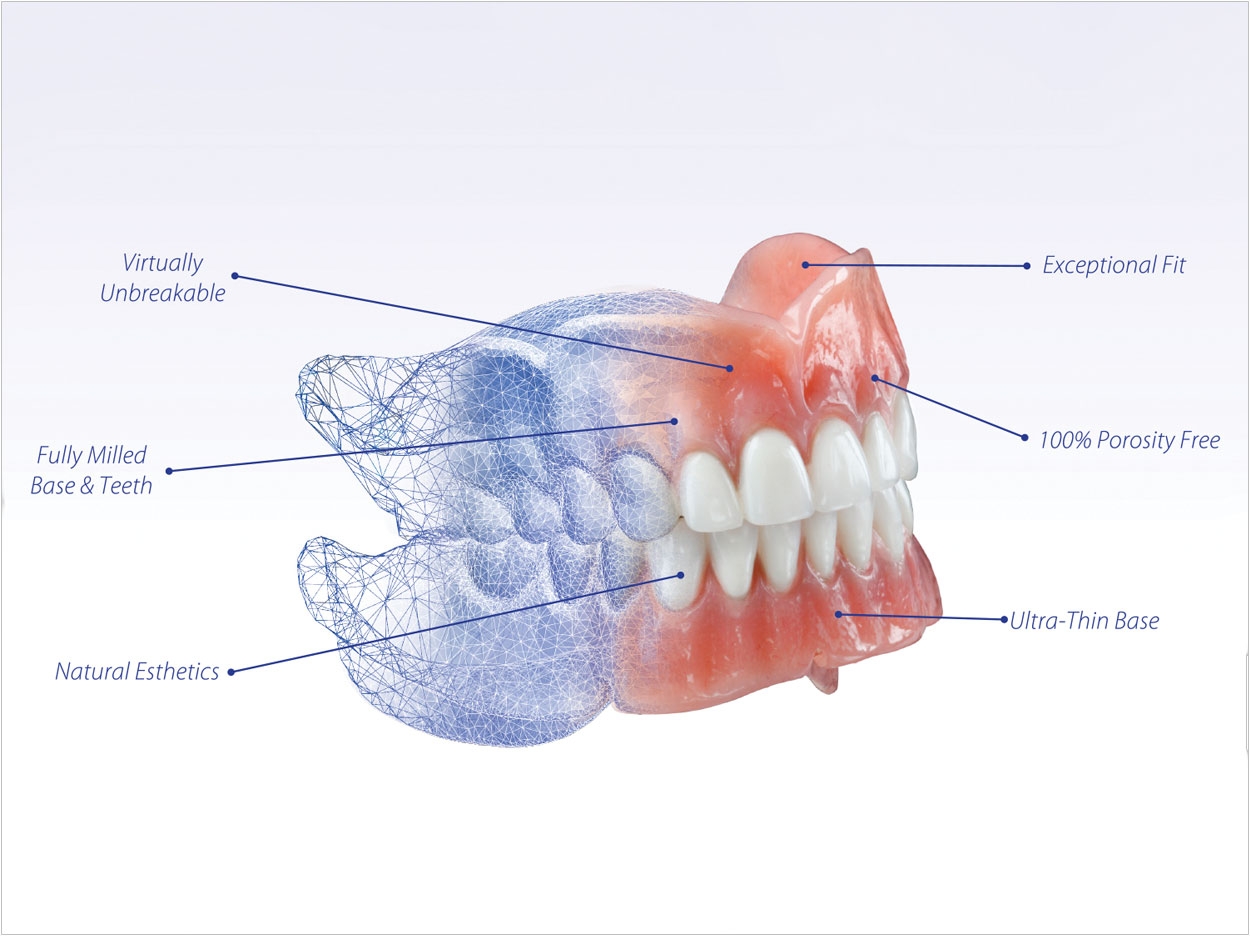
“All I Want for Christmas…”
Companies today are promising “digital dentures.” Two that are quite visible are Avadent (Global Dental Science) and Mitsui/Heraeus Kulzer, based on the DENTCA System, which is now used in Whole You’s Nexteeth System.
 |
| Milled monolithic denture properties from Avadent. |
 |
| A virtual try-in screen shot from Avadent. |
 |
| Digital denture process from Whole You. |
Digital impressions have been a popular topic of discussion during the past few years. The focus has gone from single crowns to multiple units to implants and beyond into complex cases. One area that has been lacking is fully edentulous impressions. We still have many patients who have or need dentures and are not interested in more than just that. Capturing soft tissue itself with a digital impression can of course be performed since we are constantly restoring edentulous areas, but most of these cases are tooth- or implant-borne. They do not take the periphery into consideration, and if the impression does capture that area, it is static, uncompressed tissue in the fold. Also, due to the limited field of view of the current scanners, in order to get the palate, there would be many passes back and forth. Without a reference point, it is unlikely the images could be stitched together. I have seen it done for an upper retainer using light powder, but the accuracy is questionable. There is at least one intraoral scanner in development that captures the entire arch all at once, but it is still in its infancy. (I cannot publish details, but I can answer individual inquiries.) A model of course can be scanned, but this means a traditional impression at the outset. This allows laboratories to digitally create retainers, partials, and other full-arch restorations, including the palate or flanges.
In creating well-fitting dentures, we have all learned various impression techniques to displace peripheral tissue. The term border molding comes to mind, as well as static, functional, or compression impressions. These techniques are for the stability and “suction” of the denture and require the patient to make facial movements during the impression. There is a reported idea of using compressed air in the periphery for tissue displacement, but I have not found any details. Having said this, we are seeing companies promising “digital dentures.” Two that are quite visible are Avadent (Global Dental Science) and Mitsui/Heraeus Kulzer, based on the DENTCA System. The DENTCA System is now used in the Nexteeth System, a product of the Whole You company.
Both of these systems require dentists to take traditional denture impressions but ask that they use their proprietary trays, which are quite different. In addition, each company includes with its trays a method to obtain a bite relationship, lip-line, vertical dimension, and centric and also to create a gothic arch type tracing at that first impression visit. These impressions and records are then sent to participating laboratories, scanned, and put into a digital workflow. This is where the digital system begins. Teeth are set up on the screen with software, and the try-in can be emailed to the dentist with 3-D images. This is a virtual try-in, and changes can be addressed, sent back digitally, and quickly returned. Even the lips are superimposed on the screen. If acceptable, the completed denture can be returned to the office, making this whole process a 2-visit procedure. Both companies have extensive information and clinical procedure videos on their websites: avadent.com and wholeyou.com.
Of course, those of us who are not totally trusting can request an actual try-in. Both systems will send back a denture prototype (Avadent, milled; Whole You, 3-D printed) for try-in. It is all one color, but you can see the teeth setup as well as check the vertical, centric, and fit. Modifications can be made on the trial denture, or they can simply be marked (for example, if the midline is off). Note that the tooth color is not in this try-in denture. The denture base is exactly the same fit as the final, so adjustments and even relines can be done and returned to the company. Again, you will get the virtual images sent prior to final finish for your approval. Initially, these systems were for full upper and lower dentures, but now the processes can do single-arch and immediate dentures. There are also protocols for overdentures and screw-retained dentures.
The companies’ denture processes are quite different. The Whole You System uses a milled Lucitone base with standard acrylic and composite teeth; the Avadent System uses CAD/CAM to create the final denture and mills the final denture from a block of preprocessed base material that is much stronger and lighter than traditional lab-processed materials. Additionally, Avadent recently introduced a fully milled denture where the base and teeth comprise one unit (monolithic); there are no teeth to fall out, and no seams to harbor bacteria.
There are also digital denture design software programs from 3Shape, DentalWings, and others in use by laboratories, but for now, it is still an old-fashioned impression that gets it all started.











